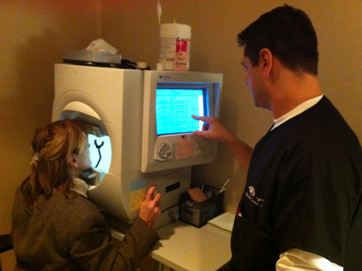Learn about the signs & symptoms of glaucoma during the month of January.
Now that we have officially entered 2012, it is time to look back on our past year and determine which aspects of our life we would like to change and improve upon. For some people, it may be the simple act of keeping better in touch with friends and family. For others, it may be a significant chance such as improving their health or quality of life.
 However, one thing that every person should try to do differently in the upcoming year is to find time in your busy schedule to take better care of yourself. While eating healthy or working out are great ways to achieve this and truly improve your health and wellness, taking better care of yourself can start simply by making regular appointments with your health care doctors in 2012.
However, one thing that every person should try to do differently in the upcoming year is to find time in your busy schedule to take better care of yourself. While eating healthy or working out are great ways to achieve this and truly improve your health and wellness, taking better care of yourself can start simply by making regular appointments with your health care doctors in 2012.
A quick trip to your optometrist may not only be a good thing for your eyes and your vision, but it could also be very beneficial for your overall health. Many people know that eye doctors can evaluate the health of your eyes and the clarity of your vision, but did you know that they can also detect chronic and systemic diseases such as diabetes, hypertension and even glaucoma?
Many people have heard of glaucoma, but few know that this dangerous vision diseases affects more than three million Americans, and over half of them will not even know that they have it. In fact, this vision problem is often called “the sneak thief of sight” since Glaucoma offers no symptoms and, once vision is lost, it is permanent.
In order to help you learn more about this dangerous vision disease during Glaucoma Awareness Month, we have put together some basic facts about Glaucoma and how it could affect you if you do not take proper preventative steps.
What Is Glaucoma?
Glaucoma is a group of eye diseases that gradually steals eye sight without warning. This disease can cause damage to our eyes optic nerve, which in turn permanently damages the vision in our affected eyes. This can progress to complete blindness if it is left untreated. Although the most common forms of glaucoma primarily affect the middle-aged and the elderly, glaucoma can affect people of all ages if proper care is not taken.
Types Of Glaucoma
 There are two main types of glaucoma: open angle and closed angle. Closed angle glaucoma can appear suddenly and the visual loss in the eyes can progress quickly. However, the discomfort of closed angle glaucoma often leads patients to seek medical attention before any permanent damage occurs. Open angle, chronic glaucoma tends to progress at a slower rate and patients may not notice they have lost vision until the disease has progressed significantly.
There are two main types of glaucoma: open angle and closed angle. Closed angle glaucoma can appear suddenly and the visual loss in the eyes can progress quickly. However, the discomfort of closed angle glaucoma often leads patients to seek medical attention before any permanent damage occurs. Open angle, chronic glaucoma tends to progress at a slower rate and patients may not notice they have lost vision until the disease has progressed significantly.
Symptoms and Treatment
In the most common form of the disease, there are virtually no signs or symptoms. However, because vision loss typically begins with peripheral or side vision, if you have glaucoma, you may not notice anything until significant vision is lost.
The best way to protect your vision from the side effects and dangers of glaucoma is to get a comprehensive eye exam on a regular basis. Those who are at higher risk of developing the disease (African Americans, Hispanics, people over the age of 60, those with a family history of the disease) should have an eye exam at least every one to two years.
If you are interested in learning more about Glaucoma or are interested in scheduling a free vision consultation, be sure to contact OCLI today.